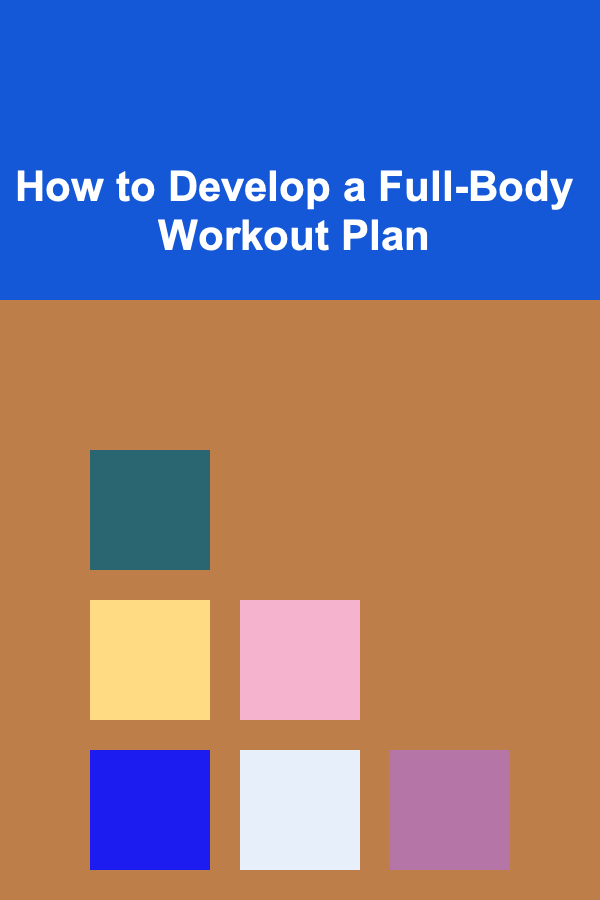
How to Develop a Full-Body Workout Plan
ebook include PDF & Audio bundle (Micro Guide)
$12.99$7.99
Limited Time Offer! Order within the next:

Introduction: The Power of Full-Body Training
In the realm of fitness, there are myriad approaches to building strength, endurance, and overall well-being. Among these, the full-body workout stands out as a particularly efficient and effective method. Unlike split routines that focus on isolated muscle groups on different days, a full-body workout targets all major muscle groups in a single session. This approach offers numerous advantages, including improved hormonal response, increased caloric expenditure, enhanced recovery, and greater time efficiency. This comprehensive guide delves into the intricacies of designing and implementing a successful full-body workout plan, covering everything from understanding the fundamental principles to selecting appropriate exercises and optimizing your routine for long-term progress.
Understanding the Benefits
Before diving into the specifics of workout design, it's crucial to understand the benefits that full-body training provides:
- Increased Caloric Expenditure: Engaging multiple muscle groups simultaneously elevates your heart rate and increases the demand for energy, leading to a higher overall caloric burn during and after the workout.
- Enhanced Hormonal Response: Full-body workouts stimulate the release of anabolic hormones such as testosterone and growth hormone, which are essential for muscle growth, recovery, and overall well-being. These hormones circulate systemically, benefiting all muscle groups.
- Improved Recovery: By working all muscle groups together, you allow for more frequent rest days, promoting better recovery and reducing the risk of overtraining. Unlike split routines that might stress a specific muscle group multiple times per week, full-body training ensures adequate recovery time between sessions.
- Greater Time Efficiency: For individuals with busy schedules, full-body workouts offer a time-efficient way to achieve comprehensive fitness goals. You can effectively target all major muscle groups in just a few sessions per week, maximizing your results with minimal time commitment.
- Functional Strength Development: Full-body exercises often involve compound movements that mimic real-life activities, leading to improved functional strength and coordination. This translates to better performance in everyday tasks and reduced risk of injury.
- Suitable for All Levels: Full-body workouts can be adapted to suit individuals of all fitness levels, from beginners to advanced athletes. The intensity, volume, and exercise selection can be adjusted to match your current abilities and goals.
Key Principles of a Full-Body Workout Plan
A successful full-body workout plan is built upon several fundamental principles:
- Focus on Compound Exercises: Compound exercises engage multiple muscle groups simultaneously, making them the cornerstone of any effective full-body routine. Examples include squats, deadlifts, bench presses, overhead presses, and rows. These exercises not only build strength but also improve coordination and functional fitness.
- Proper Exercise Selection: Choose exercises that target all major muscle groups, including the legs, back, chest, shoulders, and core. Aim for a balanced approach that addresses both pushing and pulling movements.
- Progressive Overload: Gradually increase the weight, repetitions, or sets over time to challenge your muscles and promote continuous growth. This is the principle of progressive overload, and it's essential for long-term progress.
- Adequate Rest and Recovery: Allow sufficient rest between sets and workouts to allow your muscles to recover and rebuild. Aim for at least one day of rest between full-body workouts.
- Proper Form and Technique: Prioritize proper form and technique over lifting heavy weight. Using correct form minimizes the risk of injury and ensures that you are effectively targeting the intended muscle groups. If you are unsure about proper form, consult with a qualified personal trainer.
- Warm-up and Cool-down: Always begin your workout with a proper warm-up to prepare your muscles for exercise and end with a cool-down to promote recovery. A dynamic warm-up can increase blood flow and flexibility. Static stretching during a cool-down helps reduce muscle soreness.
- Listen to Your Body: Pay attention to your body's signals and adjust your workout accordingly. If you are feeling pain, stop the exercise and consult with a healthcare professional.
- Nutrition and Hydration: Fuel your body with a balanced diet that supports muscle growth and recovery. Stay hydrated by drinking plenty of water throughout the day. Protein is especially important for muscle repair.
Designing Your Full-Body Workout: A Step-by-Step Guide
Creating a personalized full-body workout plan involves several key steps:
1. Define Your Goals
Clearly define your fitness goals. Are you aiming to build muscle, lose weight, improve strength, or enhance overall fitness? Your goals will influence your exercise selection, sets, reps, and rest periods. For example, if your goal is hypertrophy (muscle growth), you might focus on a rep range of 8-12 with moderate weight. If your goal is strength, you might focus on a lower rep range (3-5) with heavier weight.
2. Assess Your Current Fitness Level
Honestly assess your current fitness level. Are you a beginner, intermediate, or advanced exerciser? Choose exercises and weights that are appropriate for your current abilities. Starting too aggressively can lead to injury and discouragement. Consider consulting with a personal trainer to get an accurate assessment of your fitness level.
3. Select Your Exercises
Choose a variety of exercises that target all major muscle groups. A well-rounded full-body workout should include exercises for the legs, back, chest, shoulders, and core. Here's a breakdown of potential exercises for each muscle group:
- Legs: Squats (back squats, front squats, goblet squats), Deadlifts (conventional, sumo, Romanian), Lunges (forward, reverse, lateral), Leg Press, Leg Extensions, Hamstring Curls, Calf Raises.
- Back: Pull-ups (or Lat Pulldowns), Rows (barbell rows, dumbbell rows, cable rows), Face Pulls, Hyperextensions.
- Chest: Bench Press (flat, incline, decline), Dumbbell Press (flat, incline, decline), Push-ups, Dips (if you have the strength), Cable Flyes.
- Shoulders: Overhead Press (barbell, dumbbell), Lateral Raises, Front Raises, Rear Delt Flyes, Arnold Press.
- Core: Planks, Crunches, Leg Raises, Russian Twists, Bicycle Crunches, Dead Bugs, Hanging Leg Raises.
Prioritize compound exercises and incorporate isolation exercises to target specific muscle groups if desired.
4. Determine Your Sets, Reps, and Rest Periods
The number of sets, reps, and rest periods will depend on your goals and fitness level. Here are some general guidelines:
- Beginners: 2-3 sets of 10-12 reps for each exercise, with 60-90 seconds of rest between sets. Focus on mastering proper form.
- Intermediate: 3-4 sets of 8-12 reps for each exercise, with 60-90 seconds of rest between sets. You can start to increase the weight and incorporate more challenging variations.
- Advanced: 3-5 sets of 6-12 reps for each exercise, with 60-120 seconds of rest between sets. You can use heavier weights, more complex exercises, and advanced training techniques.
Adjust these guidelines based on your individual needs and preferences.
5. Structure Your Workout
Organize your exercises into a logical sequence. A common approach is to start with the largest muscle groups and progress to the smaller muscle groups. Here's an example of a full-body workout structure:
- Warm-up: 5-10 minutes of light cardio and dynamic stretching.
- Squat Variation: (e.g., Back Squat, Front Squat)
- Horizontal Push: (e.g., Bench Press, Dumbbell Press)
- Horizontal Pull: (e.g., Barbell Row, Dumbbell Row)
- Vertical Push: (e.g., Overhead Press)
- Vertical Pull: (e.g., Pull-ups, Lat Pulldowns)
- Deadlift Variation (Optional): (e.g., Deadlift, Romanian Deadlift) - alternate this each workout to avoid overtaxing the lower back.
- Accessory Exercises: (e.g., Bicep Curls, Tricep Extensions, Calf Raises, Core Exercises)
- Cool-down: 5-10 minutes of static stretching.
You can adjust this structure to fit your individual preferences and goals.
6. Schedule Your Workouts
Determine how many days per week you will train. A common frequency for full-body workouts is 2-3 times per week, with at least one day of rest between workouts. Consistency is key, so choose a schedule that you can realistically stick to.
7. Track Your Progress
Keep track of your workouts, including the exercises you performed, the weight you lifted, the number of sets and reps, and how you felt. This will allow you to monitor your progress and make adjustments to your plan as needed. Consider using a workout journal or a fitness tracking app.
8. Periodically Re-evaluate and Adjust
Regularly re-evaluate your workout plan and make adjustments as needed. As you get stronger and more experienced, you will need to increase the weight, change the exercises, or modify the sets, reps, and rest periods to continue challenging your muscles and promoting growth. Also, consider changing your routine every few months to prevent plateaus and maintain motivation.
Example Full-Body Workout Routines
Beginner Full-Body Workout (2 Days per Week)
This routine is designed for individuals who are new to strength training. Focus on mastering proper form and gradually increasing the weight as you get stronger.
Workout A
- Squats: 2 sets of 10-12 reps
- Push-ups (or Knee Push-ups): 2 sets of as many reps as possible (AMRAP)
- Dumbbell Rows: 2 sets of 10-12 reps per arm
- Overhead Press (Dumbbell or Barbell): 2 sets of 10-12 reps
- Plank: 2 sets, hold for 30-60 seconds
Workout B
- Goblet Squats: 2 sets of 10-12 reps
- Dumbbell Bench Press: 2 sets of 10-12 reps
- Lat Pulldowns (or Assisted Pull-ups): 2 sets of 10-12 reps
- Dumbbell Lateral Raises: 2 sets of 12-15 reps
- Crunches: 2 sets of 15-20 reps
Intermediate Full-Body Workout (3 Days per Week)
This routine is designed for individuals who have some experience with strength training. It incorporates more challenging exercises and higher volume.
Workout A
- Back Squats: 3 sets of 8-12 reps
- Bench Press: 3 sets of 8-12 reps
- Barbell Rows: 3 sets of 8-12 reps
- Overhead Press: 3 sets of 8-12 reps
- Hanging Leg Raises: 3 sets of 10-15 reps
Workout B
- Romanian Deadlifts: 3 sets of 10-12 reps
- Incline Dumbbell Press: 3 sets of 8-12 reps
- Pull-ups (or Lat Pulldowns): 3 sets of as many reps as possible (AMRAP) or 8-12 reps
- Dumbbell Lateral Raises: 3 sets of 12-15 reps
- Plank: 3 sets, hold for 30-60 seconds
Workout C
- Lunges (Dumbbell or Barbell): 3 sets of 10-12 reps per leg
- Dumbbell Bench Press: 3 sets of 8-12 reps
- Cable Rows: 3 sets of 10-12 reps
- Arnold Press: 3 sets of 8-12 reps
- Russian Twists: 3 sets of 15-20 reps per side
Advanced Full-Body Workout (3 Days per Week)
This routine is designed for experienced lifters who are looking to push their limits. It incorporates heavier weights, more complex exercises, and advanced training techniques.
Workout A
- Back Squats: 4 sets of 6-8 reps
- Bench Press: 4 sets of 6-8 reps
- Barbell Rows: 4 sets of 6-8 reps
- Overhead Press: 3 sets of 6-8 reps, 1 set of AMRAP (as many reps as possible with a slightly lighter weight)
- Hanging Leg Raises: 4 sets of 10-15 reps
Workout B
- Deadlifts: 1 set of 5 reps, 1 set of 3 reps, 1 set of 1 rep (work up to a heavy single)
- Incline Dumbbell Press: 4 sets of 8-10 reps
- Pull-ups (Weighted if possible): 4 sets of as many reps as possible (AMRAP)
- Dumbbell Lateral Raises: 4 sets of 12-15 reps
- Plank: 3 sets, hold for 60-90 seconds
Workout C
- Front Squats: 4 sets of 8-10 reps
- Dips (Weighted if possible): 4 sets of as many reps as possible (AMRAP)
- Face Pulls: 4 sets of 15-20 reps
- Arnold Press: 4 sets of 8-10 reps
- Russian Twists (Weighted if possible): 4 sets of 15-20 reps per side
Remember to adjust these routines based on your individual needs and preferences. Always prioritize proper form and technique.
Important Considerations and Common Mistakes
While full-body workouts are highly effective, it's crucial to be aware of potential pitfalls and considerations:
- Overtraining: Avoid training too frequently or with too much intensity, as this can lead to overtraining and injury. Listen to your body and take rest days when needed. Signs of overtraining include fatigue, muscle soreness, decreased performance, and mood changes.
- Improper Form: Using incorrect form can significantly increase your risk of injury. Prioritize proper form over lifting heavy weight. Consider working with a qualified personal trainer to learn proper technique.
- Neglecting Recovery: Adequate rest and recovery are essential for muscle growth and repair. Ensure you are getting enough sleep, eating a balanced diet, and staying hydrated.
- Lack of Progression: To continue making progress, you need to progressively overload your muscles. Gradually increase the weight, repetitions, or sets over time.
- Ignoring Nutrition: Nutrition plays a crucial role in muscle growth and recovery. Ensure you are consuming enough protein, carbohydrates, and healthy fats to support your training goals.
- Skipping Warm-up and Cool-down: A proper warm-up prepares your muscles for exercise, while a cool-down promotes recovery. Don't skip these important steps.
- Neglecting Core Work: A strong core is essential for stability and injury prevention. Incorporate core exercises into your full-body routine.
Adapting the Plan for Different Fitness Goals
The provided workout routines are just examples, and you should adapt them to suit your specific fitness goals. Here's how:
- Muscle Hypertrophy (Growth): Focus on a moderate rep range (8-12), moderate weight, and shorter rest periods (60-90 seconds). Prioritize exercises that provide a good "muscle pump."
- Strength: Focus on a lower rep range (3-5), heavier weight, and longer rest periods (2-3 minutes). Prioritize compound exercises.
- Endurance: Focus on a higher rep range (15-20), lighter weight, and shorter rest periods (30-60 seconds). Consider incorporating circuit training.
- Fat Loss: Focus on a combination of strength training and cardiovascular exercise. Maintain a caloric deficit and prioritize exercises that burn a lot of calories. High-intensity interval training (HIIT) can be particularly effective.
Conclusion: Embracing the Full-Body Advantage
Developing and implementing a well-designed full-body workout plan offers a powerful and efficient path to achieving your fitness goals. By understanding the principles of exercise selection, progressive overload, and proper recovery, you can create a routine that builds strength, enhances endurance, and improves overall well-being. Remember to listen to your body, prioritize proper form, and make adjustments as needed. Whether you are a beginner or an experienced lifter, full-body training can be a valuable tool for achieving lasting results. Consistency and dedication are key to unlocking the full potential of this effective workout approach. So, embrace the challenge, stay committed to your plan, and enjoy the transformative benefits of full-body training!

How to Create a Job Interview Checklist for Managing Time and Location
Read More
How to Make Money with Crowdfunding Real Estate Platforms
Read More
How to Use Folding Furniture to Save Space in Your Home
Read More
One-Page Websites vs. Multi-Page Websites: Which Is Better for SEO?
Read More
How To Identify Marine Reptiles and Birds
Read More
Mastering Mediterranean Interior Design: A Comprehensive Guide
Read MoreOther Products

How to Create a Job Interview Checklist for Managing Time and Location
Read More
How to Make Money with Crowdfunding Real Estate Platforms
Read More
How to Use Folding Furniture to Save Space in Your Home
Read More
One-Page Websites vs. Multi-Page Websites: Which Is Better for SEO?
Read More
How To Identify Marine Reptiles and Birds
Read More